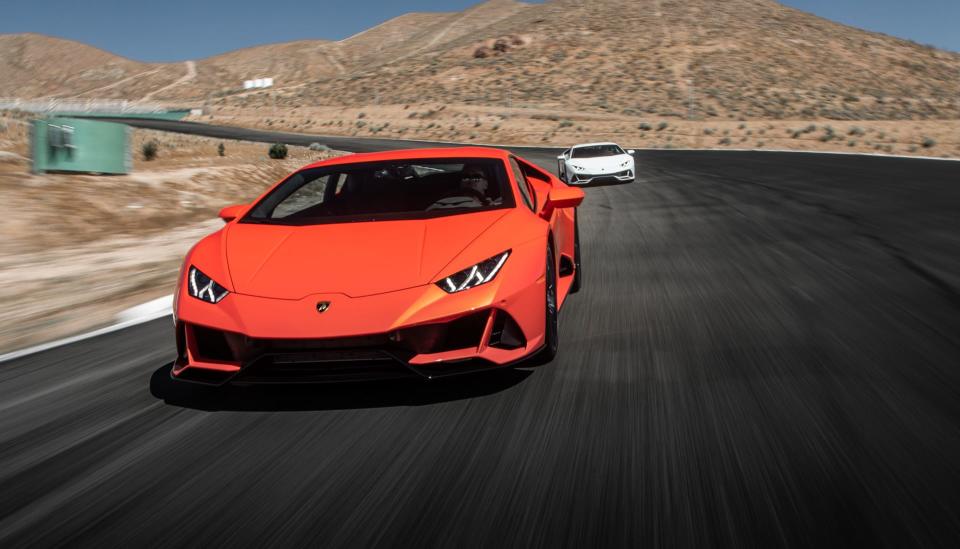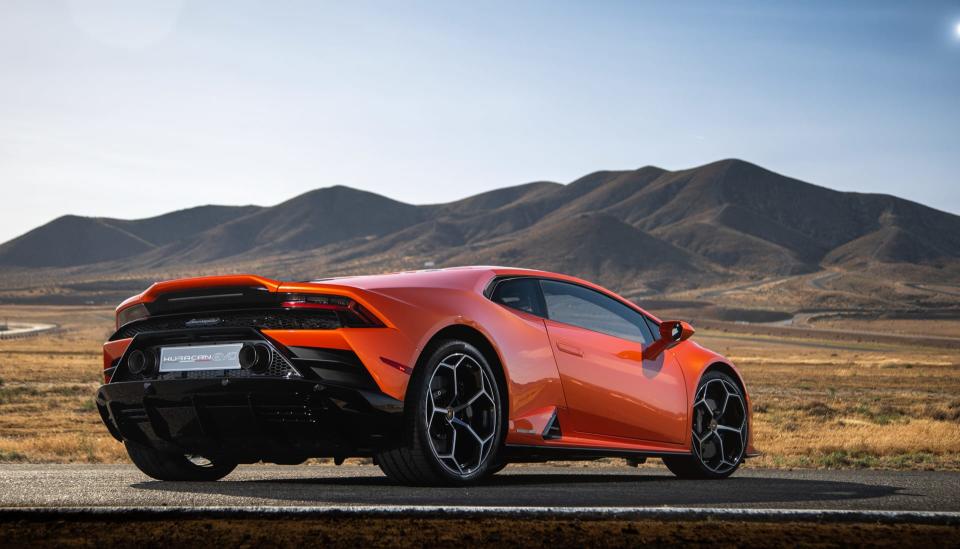Behind the wheel of Lamborghini’s supercomputer on wheels
Even when you’re driving poorly, the Huracan EVO has your back.
I'm six-foot-three-inches tall.
I mention that fact pretty often in car reviews because it adds context when I remark on head and leg room. If my large frame will fit in a compact car, maybe yours will too. Being comfortable while driving is important. If you've ever tried to operate a car while the seat is pushed forward to make room for a passenger in the back, you know how hard and potentially dangerous that is.
That said, I fit just fine in the new Lamborghini Huracan EVO. The latest supercar variant from the Italian automaker is jam-packed with tech that keeps it on the road and the person behind the wheel happy. Again, I have plenty of leg and head space to comfortably drive the rocketship with four wheels. That is, until I have to wear a racing helmet. Then, no so much.
Lamborghini invited me to Willow Springs International Raceway in the Mojave desert to try out their new 5.4-liter, 10-cylinder, 640 horsepower monster. But this beast has a leash with two leads: one controlled by the driver and one by the automaker's new LDVI system (that's short for Lamborghini Dinamica Veicolo Integrata). The onboard computer keeps track of everything the person behind the wheel and car are currently doing and predicts what's going to happen next. It sounds a bit like witchcraft, but while crammed into a Huracan EVO at Willow Springs International Raceway, I was able to get around the track's toughest corners thanks to a little help from the CPU.

LDVI is a processor that works by constantly monitoring the vehicle's all-wheel drive, all-wheel steering, grip and suspension systems. It also gets orientation data from the Lamborghini Piattaforma Inerziale (LPI), a series of gyroscopes and accelerometers that sit in the Huracan's center of gravity. The supercar is also reading data from the driver: whichever mode they've put the car in, their use of the brake and accelerator and of course, their steering.
It's a huge flow of data, and the LDVI interprets it in just 20 milliseconds and then uses that info to adjust the car's trajectory. If it were a reactive system it would be, well, fine. Adjustments after the fact can be helpful if they can right the vehicle after, say a steering mistake. Instead, Lamborghini says it created a predictive system, something that takes in a ton of information and knows what's about to happen next. It's a bold promise and in my testing, they've succeeded.
I learned this while wearing a helmet that suddenly consumed any headroom available in the Huracan EVO. An hour earlier (before I donned the helmet) I was comfortably sitting in a supercar going through a slalom and learning about one of the more difficult turns at the track.
But if I wanted to get any track time, I had to wear a helmet and suddenly my sitting position including scooching my butt to the edge of my seat so that bumps wouldn't snap my neck. My knees were essentially touching each side of the steering wheel and my arms were bent at a weird angle and instead of a light touch on the steering wheel, I was gripping it like a mad man to overcome any friction from my knees which were also in the way when I went around sharper turns. I looked like a curled-up shrimp in a polo shirt.

The result of this lower-back torturing position was that I was that my driving was subpar, to say the least. But, to the LDVI's credit, it corrected my many errors in real time. It adjusted my trajectory ever so slightly around a sharp downhill corner multiple times where I just couldn't get the right line.
The adjustments never felt overbearing or impeded my input. Instead, it was tiny corrections to a series of less-than-stellar laps around a technical track by a man hunched over in the fetal position behind the wheel. If you're someone who can throw down $260,000 for a car but your driving skills don't include time behind the wheel of a powerful vehicle, LDVI can help. It won't cure bad driving, but it will help correct small issues while you progress.
So, while I was unable to experience a Lamborghini while driving at my full potential, I was able to test out the automaker's impressive supercomputer. It still delivered an enjoyable drive and is a good reminder that eventually that tech will make its way into the cars that regular people can afford. Not so much for track driving, but for safety.
